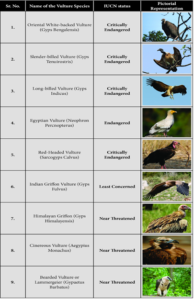Context
Researchers have recorded the first instance of captive breeding of the Himalayan vulture in India at the Assam State Zoo, Guwahati. About Himalayan Vulture (Gyps himalayensis):- The Himalayan vulture is a common winter migrant to the Indian plains, and a resident of the high Himalayas.
- IUCN Status: Near Threatened
- They are one of the two largest Old-World vultures and true raptors.
- The Himalayan vulture mostly lives the Himalayas on the Tibetan plateau (India, Nepal and Bhutan, central China and Mongolia) and is also found in the Central Asian mountains (from Kazakhstan and Afghanistan in the west to western China and Mongolia in the east).
- Vulture numbers saw a decline as much as 90% in some species in India since the 1990s in one of the most drastic declines in bird populations in the world.
- Between the 1990s and 2007, numbers of three presently critically-endangered species, the Oriental white-backed, long-billed and slender-billed vultures decreased massively with 99% of the species having been wiped out.
- The number of red-headed vultures, also critically-endangered now, declined by 91% while the Egyptian vultures by 80%.
| S. No | Category | Vulture Name |
| 1 | Critically Endangered | 1. Oriental White-backed Vulture 2. Long-billed Vulture 3. Slender-billed Vulture 4. Red-headed Vulture |
| 2 | Endangered | Egyptian Vulture |
| 3 | Near Threatened | 1. Himalayan Vulture 2. Cinereous Vulture 3. Bearded Vulture |
| 4 | Least Concern | Eurasian Griffon |
 Why vultures matter?
Why vultures matter?
- Vultures feeding on dead animals help areas getting rid of carcasses that, otherwise, would provide foul smells and scenery for a much longer period hence also known as nature’s cleanup crew.
- Vultures also play a valuable role in keeping wildlife diseases in check.
- Contribution in Detritus food chain and acts as a keystone species.
Keystone species:
|
- Detritus food chain is the type of food chain that starts with dead organic materials. The dead organic substances are decomposed by microorganisms.
| The organisms that feed on dead organic matter or detritus are known as detritivores or decomposers. |
- Diclofenac Contamination: Vultures feed on carcasses of dead farm animals and get exposed to the non-steroid anti-inflammatory drug (NSAID), diclofenac which causes kidney failure and death.
- 99% of the mortality of Oriental.
- White-backed, slender-billed and long-billed vultures are due to diclofenac.
- Habitat Loss: Vultures populations are declining due to habitat loss, food unavailability, and electrocution.
- Degradation of nesting sites due to cutting down of trees for agriculture, urbanization, and firewood, fire and grazing is a threat to vultures.
- Low Food Availability: Dead animals are the primary source of food for vultures, but the practice of throwing carcasses in the open has almost vanished, leading to a decrease in available food.
- Bioaccumulation: means an increase in the concentration of a chemical in a biological organism over time, compared to the chemical’s concentration in the environment.
- Four Vulture Conservation Breeding Centre has been established by Bombay Natural History Society (BNHS) at Pinjore in Haryana, Bhopal in Madhya Pradesh, Rani in Assam, and Rajabhatkhawa in West Bengal are involved in conservation breeding of the
- White-rumped vulture (Gyps bengalensis)
- Slender-billed vulture (Gyps tenuirostris)
- Indian vulture (Gyps indicus)
- Vulture Conservation 2020-2025: A Vulture Care Centre (VCC) was set up at Pinjore, Haryana in 2001 to study the cause of deaths of vultures in India.
- The Jatayu Conservation Breeding Centre in Pinjore is the world’s largest facility within the state’s Bir Shikargah Wildlife Sanctuary for the breeding and conservation of Indian vulture species.
- SAVE (Saving Asia’s Vultures from Extinction): The consortium of like-minded, regional and international organizations, created to oversee and coordinate conservation, campaigning and fundraising activities to help the plight of south Asia’s vultures.
- Ramadevarabetta Vulture Sanctuary: The vulture sanctuary was officially set up in 2012, but the long-billed, Egyptian and white-backed vultures have been roosting in the hills of Ramanagara for several decades. These are the three species found in Ramanagara out of the nine found in India.
Post Views: 184
